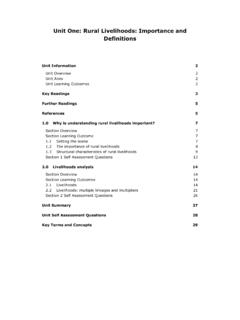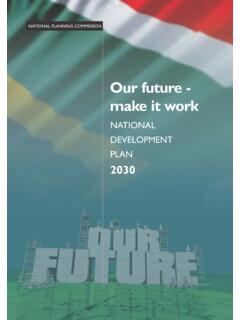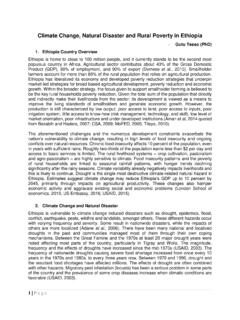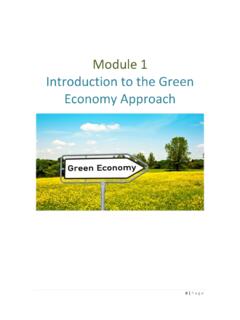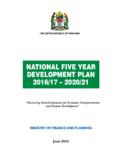Transcription of OVERVIEW: RURAL POVERTY IN DEVELOPING COUNTRIES: …
1 1 OVERVIEW: RURAL POVERTY IN DEVELOPING COUNTRIES: ISSUES, POLICIES AND CHALLENGES David Suttie, Global Engagement Specialist, IFAD Background: Inequality, POVERTY and disempowerment especially impact RURAL people Globally, extreme POVERTY continues to be overwhelmingly RURAL : an estimated 79 per cent of those experiencing POVERTY live in RURAL With latest figures indicating that in 2015 there were around 736 million people living in extreme POVERTY globally down from nearly 2 billion in 1990 - it can be surmised that the number of poor RURAL people in the world today in likely in the realm of 580 million.
2 Taking into account multiple-dimensional aspects of deprivation including, for example, access to education and essential services the rurality of POVERTY becomes even more stark: an estimated per cent of POVERTY is RURAL taking this approach. Much of this POVERTY is concentrated in sub-Saharan Africa, home to approximately 413 million poor people, where the POVERTY rate at 41 per cent is notably higher than all other regions of the world, where it is below 13 per cent; globally 10 per cent of the world's population lives in extreme POVERTY , down from 36 per cent in 1990.
3 Notably, Africa remains the world's most RURAL region, with still 60 per cent of the population living in RURAL areas as of 2014, though with urbanization proceeding rapidly this figure is projected to decline to 44 per cent by In Asia, with structural transformation more advanced and many RURAL people having benefitted from the Green Revolution, the question is more of addressing pockets of POVERTY , where RURAL some people especially those operating on remote and marginal farmlands not connected to urban markets have been left behind in the economic transformation of previous decades.
4 Similarly, in Latin America pockets of RURAL POVERTY remain though societies have largely urbanized. In general, there are strong indications that, under prevailing political economy frameworks in most DEVELOPING countries, living in a RURAL area increases a person's probability of suffering from POVERTY and deprivation. This is supported by the reality that the global POVERTY rate in RURAL areas ( per cent) is more than three times as high as that in urban areas ( per cent). Issues of political participation link with and influence factors such as under-investment in RURAL infrastructure and service provision serve to reinforce RURAL -urban inequalities and suggest the persistence of what Lipton referred to decades ago as the "urban bias in development".
5 3 Consequently, Key stakeholders in RURAL communities, including RURAL women, RURAL youth, smallholder farmers, indigenous peoples and RURAL landless workers, are among those most likely to be left behind. Not surprisingly, the lack 1 Unless otherwise stated, figures on numbers and percentages of people living in POVERTY are drawn from: World Bank. 2018. POVERTY and Shared Prosperity 2018: Piecing Together the POVERTY Puzzle. World Bank, Washington, World Bank. 2 United Nations, Department of Economic and Social Affairs (UNDESA), Population Division.
6 2015. World Urbanization Prospects: The 2014 Revision. New York, UNDESA. 3 Lipton M. 1982. Why poor people stay poor. In: Harriss J (ed) In RURAL Development: Theories of Peasant Economy and Agrarian Change. Hutchinson University Library for Africa, London. 2 of progress in RURAL areas and prevailing RURAL -urban disparities has been cited as one of the reasons aggregate progress was held back in the Millennium Development Goal It is especially alarming that the prospects of children and youth in RURAL areas are often held back compared with children in urban areas: they are more likely to be out of school5 and to be involved in child labour, most of which is concentrated in The most pronounced inequalities occur when rurality intersects with other forms of marginalization, resulting from variables such as gender, ethnicity and age.
7 For example, in most countries, while RURAL youth have lower literacy rates than urban youth, for RURAL female youth the situation is even more stark, with less than half having basic literacy skills, impeding employment and entrepreneurship The drivers of RURAL POVERTY may be broken into three dimensions: economic, social and environmental. From the economic side, low levels of productivity, lack of diversification of RURAL economies and access to markets to a large extent emanate diseconomies of scale associated with providing RURAL infrastructure and services. From a social perspective, patterns of exclusion in RURAL communities may undermine cohesion in some contexts and mean that certain groups may face addition challenges in enhancing livelihoods .
8 For example, the constraints facing RURAL women are exacerbated by gender-based power imbalance and lack of gender awareness in policy implementation, leading to persistent gender gaps related to outcomes such as land ownership, productivity, and RURAL wages. With respect to the environment, biodiversity loss and environmental degradation particularly impact RURAL people who generally rely heavily upon natural resources for their livelihood sources, most commonly through agriculture. And there is increasing awareness that the already severe effects of climate change are serving to exacerbate challenges facing poor RURAL people.
9 These challenges represent significant impediments to the achievement of the ambitions of the 2030 Agenda, not least the commitment to leave no-one behind. Emerging opportunities: linking RURAL people with opportunities in dynamic and expanding markets Most RURAL people rely on activities within food systems most prominently primary production for their livelihoods . Many are represented within the numbers of those living and working on the estimated 500 million family farms in the world, most of which tend to be relatively small. 8 These smallholder agricultural systems are often the bedrock of RURAL economies, along with the non-farm activities within agri-food systems that support them, from upstream activities to support production (for example, provision of seeds, machinery) to the downstream activities to support marketing and consumption (for example, storage, transport and retailing).
10 As such, the focus of this analysis is closely tied to smallholder food systems and related economic activities that dominate the livelihood activities of poor RURAL people. 4 UNECA/AU/AfDB/UNDP. 2015. MDG Report 2015: Lessons Learned in Implementing the MDGs: Assessing Progress in Africa towards the Millennium Development Goals. Addis Ababa: United Nations Economic Commission for Africa, African Union, African Development Bank and United Nations Development Programme. 5 RURAL children remain twice as likely as urban children to be out of school.











